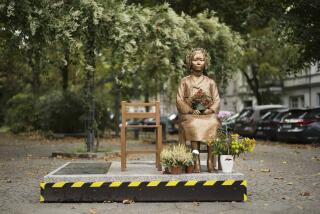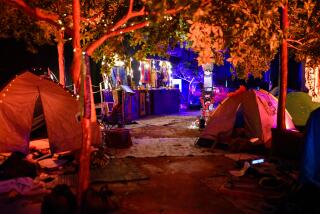Filling in the story of Nazis’ gay victims
Encouraged by attendance at a traveling exhibition on the persecution of gays by the Nazis, the Los Angeles Museum of the Holocaust is trying to raise money for a permanent show on the subject.
“We had 1,000 walk-ins last month,” twice the usual number, said Rachel Jagoda, executive director of the Westside museum, where the exhibition opened in May.
Jagoda estimates that it would cost $200,000 to create a show on gays and the Holocaust for the museum’s permanent collection. She said the museum is calling its fund-raising effort the Reinventing the Triangle Project -- a reference to the pink triangle the Nazis forced gay men to wear in labor and concentration camps.
“We want to educate future generations about the history of homosexual persecution and ‘reinvent’ the triangle as a symbol for fighting discrimination in all its forms,” Jagoda wrote, in announcing the project. She said the museum has received a gift of $10,000 toward creating a permanent show on gays and the Holocaust.
Curated by the United States Holocaust Memorial Museum in Washington, “Nazi Persecution of Homosexuals 1933-1945” has been a revelation to visitors, Jagoda said. Many were unaware that after Hitler came to power in 1933, gay men were harassed, vilified, incarcerated, tortured and sometimes castrated and executed under the Nazi’s draconian revision of Germany’s anti-sodomy law.
More than 100,000 were arrested. An estimated 15,000 were shipped to concentration camps, where their pink triangles made them targets for homophobic sadists in jackboots. More than half did not survive.
Lesbians were also harassed but not with the same fervor as gay men.
“It was a hard exhibit to research because it’s such an under-documented experience,” Jagoda said.
The paucity of artifacts relating to gays and the Holocaust is reflected in the show, which continues through Sunday. The show’s kiosks report the historical facts and feature mug shots of gay men deemed degenerate traitors by the Nazis. The victims’ stories become unbearable when juxtaposed with their faces, like that of handsome, young Gerhard Grunwald, who was arrested on July 13, 1937, and killed himself before the month was over.
Another haunting image is a covert surveillance photo of a popular gay bar -- a reminder that the Nazis were relentless in searching out and punishing their myriad enemies, whether Jews or gays, Jehovah’s Witnesses or the disabled.
But there are no resonant artifacts comparable to the chalked suitcases and piles of spectacles that make the Holocaust so palpable in other venues.
Mel Gordon, a Berkeley expert on the erotic world of Weimar Berlin, said it is no surprise that pink triangles and other artifacts disappeared. Gays who were liberated by the Allies from labor and concentration camps were subject to arrest as criminals if they revealed that they had been imprisoned for violating Paragraph 175, the anti-sodomy statute of the German penal code, Gordon said. As a result, many destroyed their pink triangles as soon as they were able.
Ted Phillips curated the exhibition and is deputy director of exhibitions at the U.S. Holocaust Memorial Museum, where the show opened last year. He pointed out that the Nazis’ anti-sodomy law remained in effect until 1969: “Statistics indicate that the rate of arrests of gay men in the postwar period nearly matched that under the Nazis, at least until the end of the 1950s.”
Gay survivors were denied reparations until recently. And there were no monuments to the Nazis’ gay victims until the 1980s.
“There are a lot of cultural institutions that I won’t name that wouldn’t take this exhibit, and shame on them,” Jagoda said.
The subject is a controversial one in the Jewish community, since Jewish law forbids homosexual acts. But Jagoda said the museum had received only a handful of complaints.
“One person left a phone message that said, ‘This is an abomination. Take me off your mailing list,’ ” she said. “But you know who has been the most tolerant? The survivors.”
The Holocaust museum was founded in 1961 by local survivors. A modest operation near the Los Angeles County Museum of Art, it tends to be overshadowed by the larger, better-financed Museum of Tolerance on Pico Boulevard.
For the show, the museum videotaped interviews with three Jewish Holocaust survivors who recall how gays were brutalized in the camps and often shunned by other prisoners.
Steve Zikman, a 42-year-old writer who visited the show, said, “I think that it’s important for people to see that discrimination against gays is a form of hate.”
Without understanding and acceptance of those who are perceived as different, he said, “before you know it, you can be down a pretty nasty road.”
Locally, the show also includes photographs of young Christopher Isherwood and his friends in Weimar Germany, from the Isherwood archive at the Huntington Library.
When Isherwood lived in Berlin in the early 1930s, the author was thrilled by its openness about sex. In contrast to Puritanical England and America, Berlin seemed like an enlightened playground to the man whose “Berlin Stories” inspired the musical “Cabaret.” The German capital was also the center of a nascent gay liberation movement.
Technically, sexual conduct between men, or “unnatural indecency,” had been illegal in Germany since 1871, and those found guilty could be sentenced to two years in prison. But Berlin in the early ‘30s was the most permissive city in Europe.
Gordon, who wrote a book on wide-open Weimar Berlin called “Voluptuous Panic,” said it had hundreds of gay bars and clubs and a gay population of 250,000 in a city of 4 million. The Nazis destroyed this vibrant culture, just as they all but eradicated the Eastern European culture known as Yiddishkeit, Gordon said.
The Weimar Republic was so tolerant of consensual sex between adults in private that it was on the verge of passing legislation in 1929 that would have limited offenses under Paragraph 175 to those involving minors, rape or prostitution.
According to the show, the liberalized law would have passed if the stock market crash hadn’t created havoc. And had that less strict version of the German law been enacted, it would have been more liberal than the Texas law declared unconstitutional in June.
“Nazi Persecution of Homosexuals 1933-1945” travels next to the University of Minnesota on Aug. 4 and then to Michigan State University on Oct. 20.
More to Read
The biggest entertainment stories
Get our big stories about Hollywood, film, television, music, arts, culture and more right in your inbox as soon as they publish.
You may occasionally receive promotional content from the Los Angeles Times.










